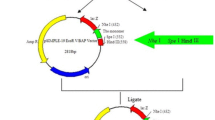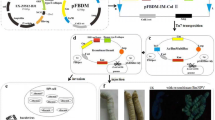Abstract
A cDNA coding for the C-terminus of spider flagelliform silk protein (AvFlag) was cloned from Araneus ventricosus. Analysis of the cDNA sequence shows that the C-terminus of AvFlag consists of 167 amino acids of a repetitive region and 87 amino acids of a C-terminal non-repetitive region. The peptide motifs found in spider flagelliform silk proteins, GPGGX and GGX, were conserved in the repetitive region of AvFlag. Phylogenetic analysis further confirmed that AvFlag belongs to the spider flagelliform silk proteins. The AvFlag cDNA was expressed as a 28 kDa polypeptide in baculovirus-infected insect cells. As a new expression approach for spider silk protein, the combination of polyhedrin and AvFlag creates a polyhedrin AvFlag fusion protein (61 kDa) that is produced as recombinant polyhedra; this provides a basis for the source of spider silk proteins for various applications.
Similar content being viewed by others
Abbreviations
- BSA:
-
bovine serum albumin
- EST:
-
expressed sequence tag
- AvFlag:
-
flagelliform silk protein from A. ventricosus
- HRP:
-
horseradish peroxidase
- MOI:
-
multiplicity of infection
- PAUP:
-
Phylogenetic Analysis Using Parsimony
- PFU:
-
plaque-forming units
- PAGE:
-
polyacrylamide gel electrophoresis
References
Arcidiacono S, Mello C, Kaplan D, Cheley S and Bayley H 1998 Purification and characterization of recombinant spider silk expressed in Escherichia coli; Appl. Microbiol. Biotechnol. 49 31–38
Beckwitt R and Arcidiacono S 1994 Sequence conservation in the C-terminal region of spider silk proteins Spidroin from Nephila clavipes Tetragnathidae and Araneus bicentenarius Araneidae; J. Biol. Chem. 269 6661–6663
Challis R J, Goodacre S L and Hewitt G M 2006 Evolution of spider silks: conservation and diversification of the C-terminus; Insect Mol. Biol. 15 45–56
Dong Z, Lewis R V and Middaugh C R 1991 Molecular mechanism of spider silk elasticity; Arch. Biochem. Biophys. 284 53–57
Foo C W P and Kaplan D L 2002 Genetic engineering of fibrous proteins: spider dragline silk and collagen; Adv. Drug Deli. Rev. 54 1131–1143
Guerette P A, Ginzinger D G, Weber B H and Gosline J M 1996 Silk properties determined by gland-specific expression of a spider fibroin gene family; Science 272 112–115
Hayashi C Y and Lewis R V 1998 Evidence from flagelliform silk cDNA for the structural basis of elasticity and modular nature of spider silks; J. Mol. Biol. 275 773–784
Hinman M B and Lewis R V 1992 Isolation of a clone encoding a second dragline silk fibroin, Nephila clavipes dragline silk is a two protein fiber; J. Biol. Chem. 267 19320–19324
Huemmerich D, Scheibel T, Vollrath F, Cohen S, Gat U and Ittah I 2004 Novel assembly properties of recombinant spider dragline silk proteins; Curr. Biol. 14 2070–2074
Hutchinson E and Thornton J 1994 A revised set of potentials for the β-turn formation in proteins; Protein Sci. 3 2207–2216
Je Y H, Chang J H, Choi J Y, Roh J Y, Jin B R, O’Reilly D R and Kang S K 2001 A defective viral genome maintained in Escherichia coli for the generation of baculovirus expression vectors; Biotechnol. Lett. 23 575–582
Je Y H, Jin B R, Park H W, Roh J Y, Chang J H, Seo S J, Olszewski J A, O’Reilly D R and Kang S K 2003 Baculovirus expression vectors that incorporate the foreign protein into viral occlusion bodies. BioTechniques 34 81–87
Kyte J and Doolittle R F 1982 A simple method for displaying the hydrophobic character of a protein; J. Mol. Biol. 157 105–142
Laemmli U K 1970 Cleavage of structural proteins during assembly of the head of bacteriophage T4; Nature (London) 227 680–685
Lazaris A, Arcidiacono S, Huang Y, Zhou J F, Duguay F, Chretien N, Welsh E A, Soares J W and Karatzas C N 2002 Spider silk fibers spun from soluble recombinant silk produced in mammalian cells; Science 295 472–476
Lee K S, Chung E H, Han J H, Sohn H D and Jin B R 2003 cDNA cloning of a defender against apoptotic cell death 1 (DAD1) homologue, responsive to external temperature stimulus from the spider, Araneus ventricosus; Comp. Biochem. Physiol. B. 135 117–123
Lee K S, Kim S R, Park N S, Kim I, Kang P D, Sohn B H, Choi K H, Kang S W, Je Y H, Lee S M, Sohn H D and Jin B R 2005 Characterization of a silkworm thioredoxin peroxidase that is induced by external temperature stimulus and viral infection; Insect Biochem. Mol. Biol. 35 73–84
Lewis R V, Hinman M, Kothakota S and Fournier M J 1996 Expression and purification of a spider silk protein: a new strategy for producing repetitive proteins; Protein Exp. Purif. 7 400–406
O’Reilly D R, Miller L K and Luckow V A 1992 Baculovirus expression vectors: a laboratory manual (New York: W H Freeman)
Swofford D L 2000 PAUP*. Phylogenetic Analysis Using Parsimony (*and Other Methods), Version 4.0 (MA: Sinauer Sunderland)
Scheibel T 2004 Spider silks: recombinant synthesis, assembly, spinning, and engineering of synthetic proteins; Microbial Cell Factories 3 14
Scheller J, Gührs K H, Grosse F and Conrad U 2001 Production of spider silk proteins in tobacco and potato; Nat. Biotechnol. 19 573–577
Van Beek J D, Hess S, Vollrath F and Meier B H 2002 The molecular structure of spider dragline silk: folding and orientation of the protein backbone; Proc. Natl. Acad. Sci. USA 99 10266–10271
Van Dijk A A, Van Wijk L L, Van Vliet A, Haris P, Van Swieten E, Tesser G I and Robillard G T 1997 Structure characterization of the central repetitive domain of high molecular weight gluten proteins. I. Model studies using cyclic and linear peptides; Protein Sci. 6 637–648
Xu M and Lewis R V 1990 Structure of a protein super fiber: spider dragline silk; Proc. Natl. Acad. Sci. USA 87 7120–7124
Author information
Authors and Affiliations
Corresponding author
Rights and permissions
About this article
Cite this article
Lee, K.S., Kim, B.Y., Je, Y.H. et al. Molecular cloning and expression of the C-terminus of spider flagelliform silk protein from Araneus ventricosus . J Biosci 32, 705–712 (2007). https://doi.org/10.1007/s12038-007-0070-8
Received:
Accepted:
Published:
Issue Date:
DOI: https://doi.org/10.1007/s12038-007-0070-8




